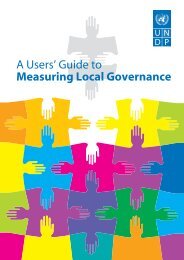planning a governance assessment - United Nations Development ...
planning a governance assessment - United Nations Development ...
planning a governance assessment - United Nations Development ...
Create successful ePaper yourself
Turn your PDF publications into a flip-book with our unique Google optimized e-Paper software.
• Choosing the type or types of indicators (existing and new)<br />
° Try to cover both the de facto and de jure <strong>governance</strong> situation<br />
° Try to have a mix of objective, events-based and perception-based indicators<br />
° Make sure to invest in new indicators to fill in gaps not covered by existing indicators. Then be sure to test these in<br />
terms of reliability and validity<br />
° Use proxy indicators when you can not measure something directly or if the cost of direct measurement is too high<br />
° Do not “re-invent the wheel” by developing new indicators, if existing ones are available<br />
• Choosing the appropriate sampling strategy if you are going to collect data using a survey<br />
° Make sure your sample is big enough to allow disaggregation of the data<br />
° Use probability-based (random) sampling where possible<br />
• Think about how you will present the results first, not as an afterthought<br />
° The earlier steps outlined above directly impact the type of results you will be able to report and share<br />
° Make sure you match the presentation of the results with the audience.<br />
• Make sure the entire process is transparent and also practices the principles of democratic <strong>governance</strong>,<br />
such as accountability, efficiency, fairness and participation<br />
° Make the raw data available to the public<br />
° Make all project documents, including the budget, coding of the data, and minutes from all meetings publicly<br />
available<br />
• Remember, it is better to start with a smaller more professional <strong>assessment</strong> than to aim too high<br />
and sacrifice quality<br />
The steps outlined above are dependent, to one degree or another, on some or all of the other steps. They all depend on the<br />
financial and human resources available. While money is very important, human resources are also critical for a successful<br />
<strong>assessment</strong>. Prices and quality of work vary considerably from country to country and within countries. Countries whose<br />
governments are interested in pursuing an <strong>assessment</strong>, and are willing to include a diverse group of non-government<br />
stakeholders, should be able to secure funding and technical assistance. Broad participation and the presentation of a<br />
feasible research plan will increase the chances for external funding and success. Once successful, it should possible to<br />
expand the scope of the <strong>assessment</strong>. Feasibility is the key to sustainability. Sustainability will maximize the impact of a<br />
country-led <strong>governance</strong> <strong>assessment</strong> in terms of development, policy and civic education.<br />
42<br />
Planning a Governance Assessment: A Guide to Approaches, Costs and Benefits








![GuÃa del Usuario ] - Governance Assessment Portal](https://img.yumpu.com/44740603/1/190x253/gua-a-del-usuario-governance-assessment-portal.jpg?quality=85)







